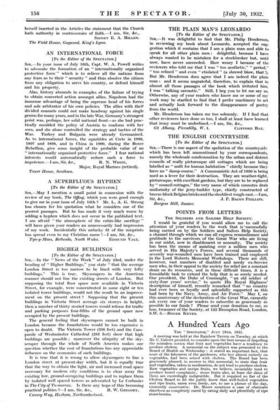HIGHER BUILDINGS
[To the. Editor of the SPECTATOR.]
Sin,—In the " News of the Week " of July 23rd, under the heading of " Higher Buildings," you state " that the average London Street is too narrow to be lined with very lofty 'buildings." This is true. Skyscrapers in the American manner should not line the existing streets of London. But supposing the total floor space now available in Victoria Street, for example, were concentrated in some eight or ten isolated tower buildings, would not the result be an improve- ment on the present street ? Supposing that the present buildings in Victoria Street average six storeys in height, then a number of thirty storied towers would release for traffic and parking purposes four-fifths of the ground space now occupied by the present buildings.
The general feeling that skyscrapers cannot be built in London because the foundations would be too expensive is open to doubt. The Victoria Tower (336 feet) and the Cam- panile of Westminster Cathedral (283 feet) show that high buildings are possible ; moreover the ubiquity of the sky- scraper through the whole of North America makes one question whether the cost of foundations has any appreciable influence on the economics of such buildings.
It is true that it is wrong to allow skyscrapers to line a London street at present-day width, but it is equally true that the way to obtain the light, air and increased road space necessary for modern city conditions is to clear away the existing low, ground-occupying buildings and to replace them by isolated well spaced towers as advocated by Le Corbusier in The City of To-morrow. Is there any hope of this becoming
practical politics ?—I am, Sir, &c., R. W. GREGORY. Causey Way, Hexham, Northumberland.






























 Previous page
Previous page